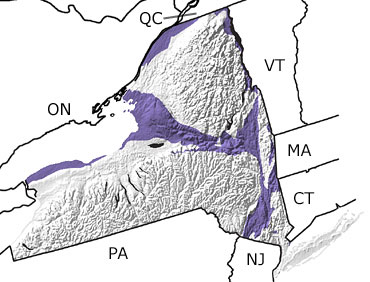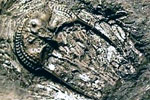Paleontology and geologyDuring the Early Ordovician, the rocks formed in New York were predominantly limestone and dolostone. Later, as sea level dropped, these sedimentary rocks were subjected to intense erosion. Toward the end of the Ordovician, volcanic islands formed along a subduction zone between North America and Western Europe. The islands collided with North America forming the Taconic Mountains in eastern New York and buckling the crust to the west, which deepened part of the sea that covered New York. Layers of volcanic ash were deposited in the sea across New York. Sediment tumbled down the mountain flanks, carried by streams into the inland sea, and formed a large delta—the Queenston Delta. Fossils include trilobites, graptolites, and bryozoans. This map indicates exposures of Ordovician rocks on the northern margins of the state and across the center and extending sourth to New Jersey. |


